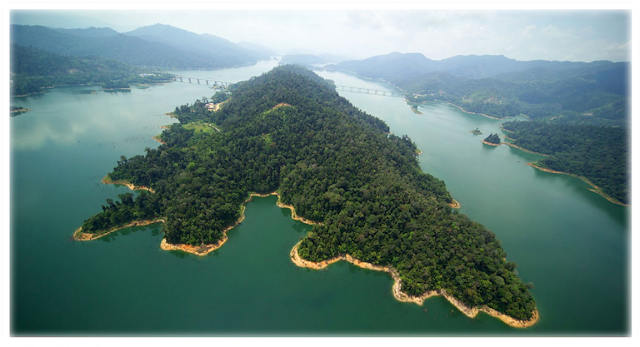 |
| Pulau Pinang National Park |
Pulau Pinang National Park is located at the northwest corner of Penang
Island overlooking the Straits of Malacca. The park is about 475 km from
Kuala Lumpur and about 30 km (45 minutes) from Georgetown, Penang.
 |
| meromictic lake |
The park caters for day use visitors only. There will be no accommodation and campsite for tourist so as to minimize human impacts on the park. Overnight camping is offered only through organized nature camp / conservation education programs by the Park Service for schools, colleges and higher learning institutions. Visitors / tourists should stay at the numerous hotels available at Batu Ferringhi and Telok Bahang, a well-established tourism area. These areas are well supported with food outlets,convenient stores, souvenir shops, entertainments, clinics and other tourist services.

The natural attractions of Pulau Pinang National Park include the Hill / Lowland Dipterocarp Forests, Mangrove Forest areas,sandy beach habitats, the unique seasonal meromictic lake and the open coastal seas. Stands of Seraya (Shorea curtisii) trees, common feature of coastal Dipterocarp Forest, can be easily seen on steep slopes around Muka Head. There are over 1000 species of plants recorded which are dominated by the family Dipterocarpaceae, Leguminoceae, Apocynaceae, Anacardiaceae, Euphorbiaceae and Moraceae.
How to get there
By own transport, drive through the North South Expressway, exit at the junction of Penang Bridge. Follow the road towards the direction of Batu Feringghi and continues to Teluk Bahang. Administrative Office of the Penang National Park is located at Jalan Hassan Abbas. Public transport to Teluk Bahang available at ferry terminal / KOMTAR or may use taxi services provided.
The main entrance to the park is through Telok Bahang while the second entrance point located at Kuala Sungai Pinang, Balik Pulau. Recreational facilities for visitors are only available at Pantai Kerachut, Sungai/Teluk Tukun, Pasir Pandak, Teluk Aling, Teluk Duyung dan Muka Head Light House. A nature trail also looped around the unique meromictic lake at Pantai Kerachut.
Teluk Tukun
At the mouth of Sungai Tukun, it is only a short 15-20 minutes walk from Park HQ. Suitable for picnics as well as those who want to stay overnight. There is a pool with the water sourced from the river. Great for a cool and refreshing dip, especially on a hot day. After the upgrades, it now contains complete facilities for campers. Toilets, showers, cooking pits and camping spots are among the amenities provided. A short walk into the jungle, one can discover a rich variety of flora and fauna. It has direct paths to other parts of the park, including Pantai Kerachut and Muka Head.
Teluk Aling
Universiti Sains Malaysia (USM) Marine Research Centre is located here. There is jetty here for the centre's use. It is a short stretch of beach.
Teluk Duyung
Popularly known as Monkey beach, named after monkeys that loiter around here. Some people also refer to here as Muka Head. A pretty long stretch of beach. You should be able to reach here from Park HQ in less than 1 and a half hours. Many hotels provide packages that includes the boat ride and BBQ lunch. You can camp here, although the facilities are not as good as Teluk Tukun and Pantai Kerachut. There is a abadoned house owned by Loh Boon Siew. There is another house that sells drinks as well as providing boat services for those lazy to walk back.
Muka Head Lighthouse
At the far end of Teluk Duyung is the starting point for the climb up to the Muka Head Lighthouse. Built in 1883 at a cost of £37,929, it is located 242m above sea level. It is opened to public if the caretaker is in. Enquire at the house at Teluk Duyung on whether the caretaker is around. It takes between 30 minutes to an hour to reach the lighthouse, depending on your fitness. From here, you can get a spectacular view of the island. On a clear day, you would be able to see Pulau Langkawi and as far as Sumatra in Indonesia.
Pantai Kerachut
Located at the western side of the park, this is a beatiful stretch of beach. Facing the Straits of Malacca, it can get pretty windy and the sea can get pretty rough here. Camping facilities and amenities are provided here. It is also a turtle nesting ground, with a turtle sanctuary located here. It is the nesting place of the Green Turtles (Chelonia mydas) from April to August and the Olive-Ridley (Lepidochelys olivacea) between September and February.

Also not to be missed is the rare meromictic lake resulting from a seasonal phenomenon. During low tides and dry seasons, the lake becomes a field of mudflats, with hardy, terrestrial grass. During spring tides, seawater enters through a one metre wide opening to fill the lake slowly. It contains both sea water and fresh water layers which never mixes, hence the name meromictic. The cool fresh water is on the top while the warm sea water lies at the bottom. It takes about 1-1.5 hours to get here from park HQ. It is a little bit more challenging than the trail to Muka Head, as one has to climb up a hill to get here. However, it is definitely worth the time and effort.
Teluk Kampi
Located at the far south-western end of the Park, this is the longest beach in the Park. However, getting here is a little bit difficult, as the trail is not very clear. One has to climb up a steep hill before going down to the beach. There are several trails that goes here. The most convenient one would be the one that starts at the end of Pantai Kerachut. Make sure you have enough water and time to make the trip.
Activities
Among the activities provided at the Penang National Park, including camping, wildlife observation, canopy walkway, swiming, picnic, Interpretive Centre, fishing, jungle trekking climbing and canoeing.
Permit and License
There is no entrance fee for visitors to Taman Negara Pulau Pinang. However, for canopy walkway activity, the fee charged for adults is RM5.00 and RM3.00 for children.



































































